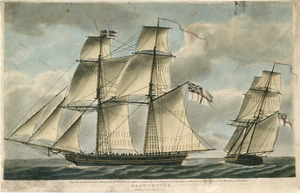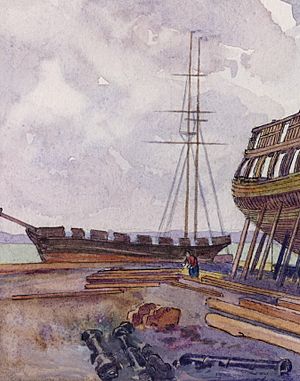HMS Duke of Gloucester (1807) facts for kids

Gloucester in 1813, drawn from a model
|
|
Quick facts for kids History |
|
|---|---|
| Name | Duke of Gloucester |
| Builder | Kingston Royal Naval Dockyard, Kingston |
| Launched | May 1807 |
| Fate | Captured on 25 April 1813 |
| Name | York |
| Acquired | Captured 25 April 1813 |
| In service | 25 April 1813 |
| Out of service | 29 May 1813 |
| Fate | Burned by the British on 29 May 1813 |
| Notes | Used as powder hulk |
| General characteristics | |
| Type | 10-gun brig |
| Tons burthen | 165 (bm) |
| Propulsion | Sails |
| Sail plan | brig |
| Armament | 10 × 12-pounder guns |
HMS Duke of Gloucester was a 10-gun brig, a type of sailing ship. It was built for the Royal Navy in 1807 at the Kingston Royal Naval Dockyard in Kingston, Ontario, Canada.
This ship was part of the Provincial Marine, a naval force that protected British interests on the Great Lakes and St. Lawrence River. During the War of 1812, Duke of Gloucester took part in early battles on Lake Ontario. In 1813, while being repaired, American forces captured the ship. About a month later, the British destroyed it during the Battle of Sackett's Harbor.
Contents
Building the Duke of Gloucester
In 1806, plans were made to build a new ship. This ship would replace an older gunboat called Swift. The new vessel was built in Kingston, Canada. It was launched in May 1807.
At first, the Duke of Gloucester was used to carry supplies and people for the government. It measured 165 tons. This meant it was small enough to enter many ports. The ship was armed with ten 12-pounder guns. Later, by the time of the War of 1812, it had six 6-pounder guns. It was also changed to be a schooner, another type of sailing ship.
The Ship's Adventures
After it was built, the Duke of Gloucester was used only by the government. By 1812, the ship's wooden body was rotting. A new ship, the Prince Regent, was ordered to replace it.
When the War of 1812 began, Lieutenant Francis Gauvreau commanded the Duke of Gloucester. The ship joined a group of British ships. This group tried to attack Sackett's Harbor on July 19, 1812. The three larger ships attacked the American forts. But Duke of Gloucester stayed further away. The attack failed, and the British ships left.
Battles and Blockades
After the failed attack, Duke of Gloucester and another ship, Earl of Moira, were sent on a new mission. Their goal was to capture American merchant ships near Ogdensburg, New York. The American Commodore Isaac Chauncey sent a schooner called Julia to stop them.
On July 31, the ships met near Elizabethtown, Canada. Earl of Moira fired at Julia but missed. However, strong gunfire from the British shore forced the Americans to go back to Ogdensburg. The next day, the British ships started to block Ogdensburg. This blockade lasted until the end of the month. Then, a short pause in the fighting allowed Julia and the merchant ships to sail to Lake Ontario. For the rest of that year, the Duke of Gloucester mainly carried supplies on Lake Ontario.
Capture and Destruction
During the winter of 1812–1813, Duke of Gloucester was sent to York, Upper Canada (now Toronto). By 1813, the ship was not fit for sailing. It was being repaired at York. The plan was to give it more guns, up to 16.
However, in 1813, American forces briefly captured York. Commodore Chauncey took guns and supplies from the town. He also towed the Duke of Gloucester back to Sackett's Harbor, New York. The Americans renamed the ship York. They then used it as a powder hulk, which is a ship used to store gunpowder.
A month later, on May 29, 1813, the British attacked Sackett's Harbor. During this Battle of Sackett's Harbor, the British destroyed the York (the former Duke of Gloucester).


